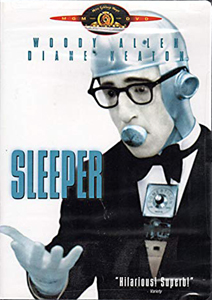“Sleeper” (1973) perhaps struck audiences as wildly clever upon its release. A rare science fiction film from writer-director Woody Allen (co-writing with Marshall Brickman), this parody especially riffs on “2001” (with the medical computer’s eyes – green instead of red – and HAL-9000 voice from Douglas Rain) and “THX-1138” (with the opaque masks that make humans seem robotic).
Making fun of future, present
Allen, who also stars as accidental time traveler Miles, uses the 22nd century to make fun of 1973 realities and timeless things. The props are at the level of “Star Trek: The Original Series,” and that’s fine when watched both then and now.
The premise is original, especially among Allen’s catalog, but “Sleeper” is a rare Allen film that lags and is overlong (despite being only 89 minutes). When our protagonist wakes up 200 years in the future and is unwrapped like tinfoil, the immediate payoff isn’t great when compared to Austin Powers taking a piss he’s been holding in while in cryostasis. Miles dazedly stumbles around the lab, and I was struck by how the scene never becomes funny.

“Sleeper” (1973)
Director: Woody Allen
Writers: Woody Allen, Marshall Brickman
Stars: Woody Allen, Diane Keaton, John Beck
“Sleeper” is pleasant enough; it’s a nice movie, a harmless movie. But it never develops momentum, leaving the few chuckles stranded in a storytelling desert. An early segment finds Miles explaining photos of famous 20th century people to a historian, ending with his pronouncement that he’ll keep the Playboy centerfold for further study. It’s like a stand-up bit plopped into a story, and I might’ve enjoyed a whole movie in this vein.
Shuffling along
A physical-comedy gag that has some miles (pun intended) is Miles – having disguised himself as a servant robot – shuffling around robot-style; the sound designer brings the shuffling sound to the fore. Another laugh comes from a callback to “Bananas” (1971) wherein Miles exchanges flirtatious looks with a cute blonde.
This gag is also used in “Love and Death” (1975) and I now realize it’s like the staredowns in “Curb Your Enthusiasm” – a purposefully ridiculous running gag for fans to enjoy.
As is often the case, Allen is interested in sex, and “Sleeper” makes broadly funny technological extrapolations such as the Orgasminator, a phone-booth type of device that’s a regular feature in everyone’s apartments, as ubiquitous as suicide booths in “Futurama.” He teaches Diane Keaton’s Luna – “frigid” like all futuristic people – about old-school lovemaking.
A clunky future
In the tradition of midcentury SF writers who didn’t envision miniaturized digital tech, “Sleeper” features a lot of reel-to-reel tape, including one spool that covers a whole wall. Miles leans against it and does a pratfall in that funny flirting scene.

Speaking of physical comedy, the moments in “Sleeper” that would be action scenes in non-comedies are a series of pratfalls of Miles – and later, Luna – fighting off the authorities. Jaunty music plays behind the events. It gets a little old.
“Sleeper” is not a film worth hating, but I find it to be a thrown-together Allen effort; in some scenes, including the closing one, an actor stumbles over a line and that’s the take he goes with. Of course, Allen and Keaton have good chemistry, but they have much less to work with here than in their other collaborations, especially the masterpieces “Play It Again, Sam” and “Annie Hall.”
Allen’s political views as expressed in “Sleeper” – in favor of gun control but generally opposed to centralized power – are hard to categorize, further making the film struggle to click as a message piece. “Sleeper” makes fun of everything, and therefore makes fun of nothing … and isn’t as fun as it should be.

